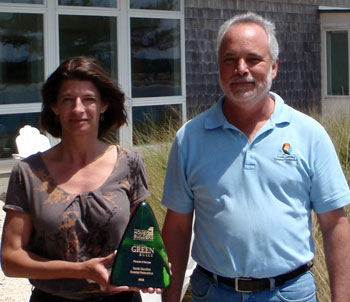WILMINGTON — The N.C. Coastal Federation and the Wilmington-Cape Fear Home Builders Association have formed a dynamic duo designed to make building eco-friendly development projects a friendlier process.
The budding relationship blossomed a couple of weeks ago when the home builders awarded the federation with the Coastal Green Built Award as part of their 26th Annual Parade of Homes Banquet. Local governments usually get the award to recognize their progress in green development, but the federation won it this year because of its work with the home builders in promoting low-impact development, or LID, to reduce the effects of stormwater from development projects.
Supporter Spotlight
“Working toward a common goal has brought us together,” says Cameron Moore, the governmental affairs director for the home builders association.
 Lauren Kolodij and Todd Miller of the N.C. Coastal Federation show off the Coastal Green Built Award. |
The organizations have been working with local governments since 2006 to promote green building and uncover obstacles to low-impact development. More specifically, the groups have been encouraging homebuilding methods to reduce stormwater runoff, using tools such as rain gardens and cisterns to lessen its effects.
“That’s part of the bigger picture.” says Moore, “The goal is to create a comprehensive plan for green building.”
Part of this comprehensive plan involves creating tools and resources to make life easier for hopeful green builders.
“In 2007, the federation assembled a team of experts to produce a low-impact development manual for voluntary use by developers,” says Lauren Kolodij, deputy director of the federation, “We also hosted training sessions on the use of this manual.”
Supporter Spotlight
The federation also contracted with an engineering firm to devise an LID stormwater permitting tool that builders and local governments can use to estimate stormwater reductions.
The organizations, however, are looking beyond simply creating references and utilities.
“We want to make not just development tools,” says Donna Girardot, the executive officer at the home builders association, “but examples for others to use.”
The idea is that as more and more green-built subdivisions, transportation lines and commercial buildings begin to emerge, other builders will take notice and integrate low-impact development into their plans. Hopefully, ideas used by green builders on the coast will flow to the rest of the state, making low-impact development the standard.
Beyond assisting development, the home builders and the federation also talk with local governments about eco-friendly building regulations.
“Our work together to date has focused on offering options for developers and not new regulations in regard to LID,” says Kolodij, “We are working with local governments to identify obstacles to LID and make recommendations on how to reduce them.”
Some of the obstacles identified so far include a lack of incentives for low-impact development and general unawareness of LID options.
Over the past few years, talks between the home builders’ association, the federation and local governments have resulted in almost limitless benefits to low-impact building. Proper planning around stormwater runoff saves space and creates a more self-sufficient environment. Advances in green building techniques have allowed low-impact development to become as cost-efficient as other methods – perhaps even more so. New methods of managing stormwater runoff and harvesting rainwater will help conserve water supplies.
“Everybody can find a benefit in low-impact development,” says Kolodij.
“We want to make it easy for builders to take the low-impact route,” Girardot says, “and encourage them to do so.”
The relationship that the federation and the home builders now share is the result of their joint efforts to promote LID. That the federation won the Coastal Green Built Award is significant, Girardot said.
“The award is significant in that the federation is the first non-governmental organization to receive it,” she said. “That says a lot.”
Moving forward, the newly found working relationship between the two groups will likely expand as they continue efforts to make LID a viable option for the development community.








